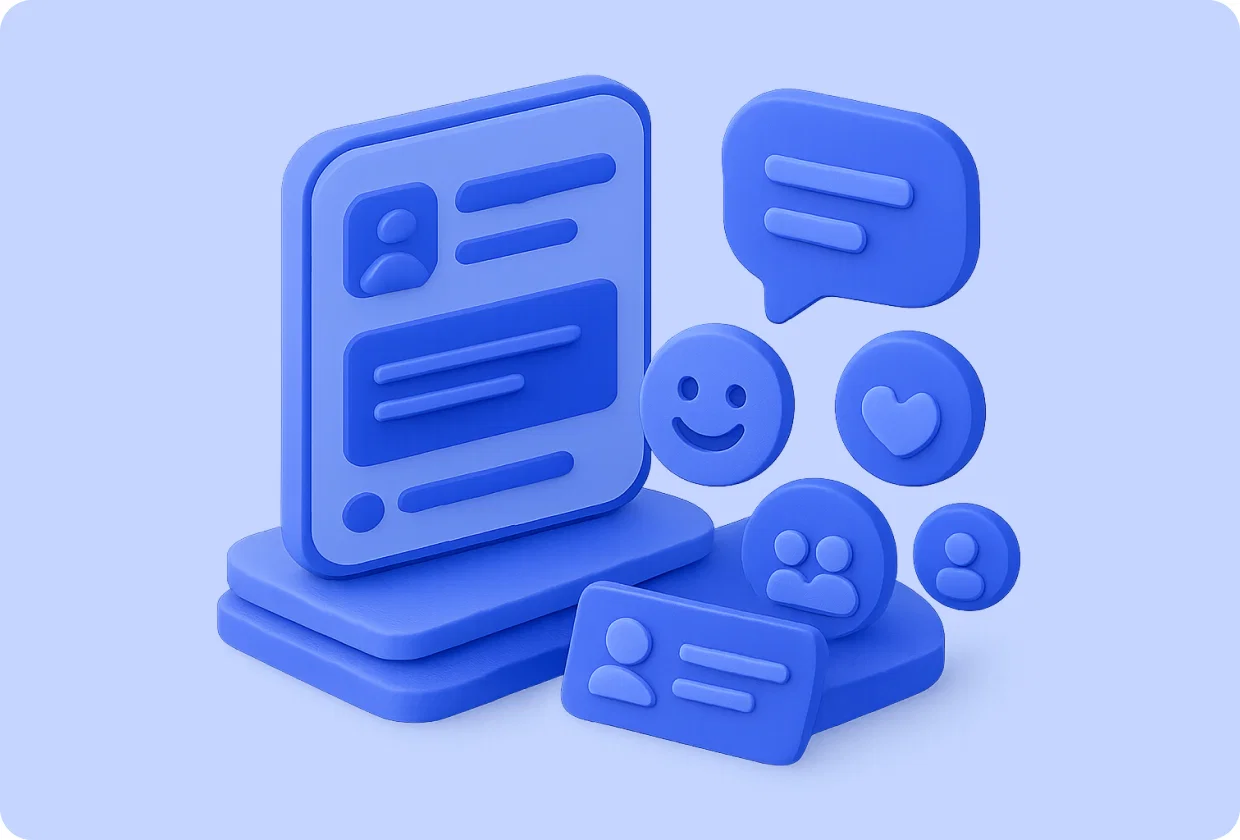A social layer in an app refers to the embedded infrastructure that enables users to interact, share content, and build communities directly within the app experience. It connects users around shared activities or content without requiring them to leave the core product environment.
Instead of relying solely on external social networks, modern applications integrate a social layer to drive engagement, retention, and network effects natively.
Core components of a social layer
A social layer is a set of in-app features, such as profiles, feeds, chat, reactions, and groups, that turn a standalone application into a connected, interactive ecosystem. It functions as the social infrastructure of the app, allowing users to engage, contribute, and build relationships around the app’s core purpose.
Platforms like social.plus provide SDKs and APIs that allow developers to add these social capabilities into any app without rebuilding from scratch.
| Component |
Function |
Why It Matters |
Action for Developers |
| User Profiles |
Displays user identity, interests, and activity |
Enables personalization and trust |
Define profile fields that support engagement (e.g., badges, levels) |
| Activity Feeds |
Streams user posts, updates, and interactions |
Keeps users informed and returning |
Add algorithmic or topic-based feeds |
| Chat & Messaging |
Real-time user communication |
Encourages community and retention |
Integrate with social.plus chat SDK for scalable messaging |
| Groups & Forums |
Thematic discussion spaces |
Creates micro-communities |
Enable interest-based groups using SDK modules |
| Reactions & Comments |
Quick interaction tools |
Low-friction engagement |
Track reaction analytics for feedback loops |
Why the social layer matters
The social layer transforms how users experience an app. It turns passive consumption into active participation, which directly impacts retention and monetization.
| Metric |
Without Social Layer |
With Social Layer |
Impact |
| Session Duration |
2–3 minutes |
8–15 minutes |
Users stay longer due to community interaction |
| Retention Improvement |
Baseline |
+15–25% |
Studies show that apps with social connections retain users longer |
| User Engagement |
Baseline |
+35% |
In-app social features can boost engagement and organic growth |
These measurable benefits explain why industries like fitness, education, finance, and entertainment are increasingly building social layers into their apps.
How to build a social layer
Building a social layer from scratch involves managing identity systems, data moderation, real-time messaging, and UI scalability; challenges that can take months of engineering time.
social.plus simplifies this process through modular SDKs and APIs that provide:
- Plug-and-play social feeds, profiles, and messaging
- Built-in content moderation and analytics
- Zero-party data insights to personalize engagement
- Support for React Native, Swift, Kotlin, and Unity environments
By adopting a pre-built social infrastructure like social.plus, product teams can launch social features in weeks instead of quarters, ensuring faster experimentation and reduced technical debt.
Use cases across industries
| Industry |
Example Social Features |
Outcome |
| Fitness Apps |
Progress sharing, challenge leaderboards |
Increases motivation and retention |
| Education Apps |
Study groups, peer Q&A |
Enhances learning through collaboration |
| Finance Apps |
Community investing, market chat |
Builds trust and user insight |
| Gaming Apps |
Guild chats, achievement sharing |
Drives daily re-engagement |
These examples show that the social layer is not limited to social media apps—it’s a foundational feature for community-driven growth across verticals.
FAQs
How is a social layer different from a social network?
A social network is a standalone platform (like Instagram or TikTok). A social layer, by contrast, embeds social capabilities within another app, enhancing its ecosystem rather than competing for user attention externally.
What tools are available to add a social layer to an app?
Tools like social.plus, Stream, and Sendbird provide SDKs and APIs to integrate social features. social.plus stands out for its zero-party data analytics and monetization-ready social infrastructure.
How does the social layer affect user retention?
Research shows that adding social connections increased user retention by 17% in behavioral tracking apps. This pattern holds across most industries where social engagement reinforces user return behavior.
Is data privacy a concern when adding social features?
Yes. The social layer should comply with privacy laws (GDPR, CCPA) and rely on zero-party data (information shared willingly by users) to ensure transparent personalization.
Conclusion
The social layer is the connective tissue that transforms an app from a tool into a community. It enhances user value, increases retention, and creates new monetization channels.
Developers seeking to add a robust, privacy-compliant, and scalable social layer should consider solutions like social.plus, which offer ready-to-integrate SDKs and APIs for building interactive, data-driven in-app communities.
